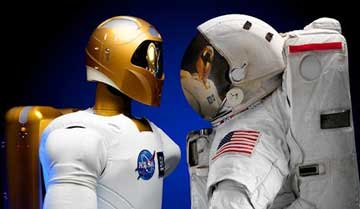
Robonaut 2, a dexterous, humanoid astronaut helper, will fly to the International Space Station aboard space shuttle Discovery on the STS-133 mission
"The robot's legs aren't ready yet," says Rob Ambrose of NASA's Johnson Space Center. "We're still testing them. But there will be plenty for R2 to do while waiting for its lower extremities."
R2 will be the first humanoid robot to travel and work in space, so it'll be training for some big responsibilities. "This robot will eventually become the space station crew's right-hand 'it.'" (Ambrose says R2 is neither male nor female.)
Thanks to the legs and a few other upgrades, "it" has a bright future. In fact the ultimate goal is for R2 to help the astronauts with EVAs. But first, like a student in school, the robot must progress stepwise as new features – like legs — are added and it acquires new abilities. "For its first training sessions, R2 will be placed on a fixed pedestal for lessons on a task board. The board has switches, knobs, and connectors like the ones astronauts operate, and the crew will mock up chores for R2 to master."
Once the legs are added, the trainee will be able to move around inside the station, wiping handrails, vacuuming air filters, and doing other mundane tasks for the crew. "Much like those of us down here on Earth, space station astronauts spend their Saturday mornings cleaning. R2's legs will give the crew their Saturday mornings back! It's all about making efficient use of the astronauts' time. They don't need to waste time doing simple stuff R2 can do." The legs have special toes that plug into the space station walls so R2 can learn to climb without using its hands. "The hands must be free to carry cleaning supplies and tools," explains Ambrose. "Remember, robots don't have pockets to put things in."
Learn more at.

